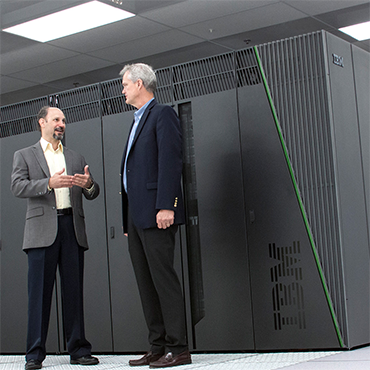U.S. Puts Top Supercomputer up for Rent
In an effort to make the country more competitive, the federal government has made one of the country’s most powerful supercomputers available to any U.S. business—so long as it meets certain requirements.
 The super in question is Vulcan, an IBM Blue Gene/Q system at the Lawrence Livermore National Laboratory (LLNL), that’s currently situated as one of the top ten supercomputers in the world.
The super in question is Vulcan, an IBM Blue Gene/Q system at the Lawrence Livermore National Laboratory (LLNL), that’s currently situated as one of the top ten supercomputers in the world.
Helping to earn the Vulcan its place at the number eight spot on the latest Top500 list are 393,216 compute cores, and speeds of up to five petaflops, or 5 quadrillion floating point operations per second.
This comes following President Obama’s 2011 State of the Union Address, when many feared that funds for supercomputing may have been on the federal chopping block. But to the surprise of some, Obama made it clear that through supercomputing, it was the government’s responsibility to provide “cutting-edge scientists and inventors with the support they need.”
This priority was underscored earlier this year when China topped the U.S. on the supercomputing Top500. While it’s yet to be seen how China’s claim to computing superiority will be put to use in industry, the announcement to offer Vulcan up to American companies suggests that the administration isn’t about to wait to find out.
A primary aim of LLNL is to ensure national security, which according to Frederick Streitz, director of the HPC Innovation Center at LLNL, is about a lot more than just defense. “The ability of the American industry to compete in the global marketplace and raising the standard of living for Americans is part of national security,” Streitz said in a video describing the lab's latest offer to industry.
But for a company to get its hands on the top-end system, they must first meet the following requirements:
1. The project in question should boost American competitiveness.
2. It should accelerate advances in science and technology.
3. It should develop the country’s skilled high performance computing (HPC) workforce.
Once these criteria are met, companies can access of up to all five petaflops. Making this possible are on-hand computational scientists and scalable software codes, both of whom help to adjust to each user’s needs.
“High performance computing is a key to accelerating the technological innovation that underpins U.S. economic vitality and global competitiveness,” says Streitz. “Vulcan offers a level of computing that is transformational, enabling the design and execution of studios that were previously impossible, opening opportunities for new scientific discoveries and breakthrough results for American industries.”
For academia, HPC offers the ability to easily tackle enormous data sets, or simulate highly complex phenomena, such as the beating of a human heart. But for industry, access to HPC often means being able to model new products and simulate them in a variety of test environments, rather than having to invest in costly prototypes for each stage of its development. At the end of the day, that could not only result in a faster time to market, but could also mean delivering a product that has been more extensively tested, and as a result has been better designed to meet customer needs.
So why haven’t more companies jumped on board already? In an interview with ComputerWorld’s Patrick Thibodeau, chief business development officer at LLNL, Jeff Wolf pointed to the costs. “Most people we’ve worked with are amazed at how much computing can be made available and how affordable the costs are, which helps companies overcome the cost barrier,” Wolf said. By using the government system, the companies end up receiving coverage for “their fair portion of the operating costs of the computer centers.”
Wolf, who is responsible for receiving applications to tap Vulcan’s power, indicated that the response from industry has already been significant. He expects the interest to intensify over the transition from summer to fall.
According to Wolf, the companies that have come forward had already reached the limits not only of what their commercial modeling and simulations tools were capable of, but in many cases companies they had reached the limit of what they could afford.
Already, LLNL has used less powerful systems associated with its “HPC4energy incubator" initiative to help businesses in the aerospace, automotive, defense, energy, healthcare, transportation and manufacturing industries for product development of all types. The lab expects that adding Vulcan to that arsenal will further boost the efforts by allowing companies to simulate even larger systems for longer periods of time with even greater fidelity and resolution.










